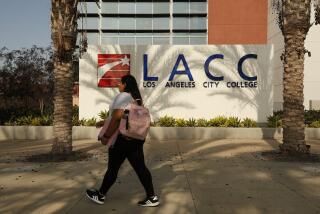Community colleges’ learning disability
Community colleges are central to the nation’s higher education system, enrolling almost 30% of all postsecondary students. But their record of success is spotty.
Nationally, only about a quarter of full-time community college students complete their studies within three years (the official measure of a school’s graduation rate).
At more than a third of California’s community colleges, graduation rates are 20% or less. Of the full-time, degree-seeking students who entered California community colleges in 2007, more than 35,000 had not earned their degrees three years later, and most of them were no longer enrolled in any postsecondary institution.
This happens year after year after year, and it’s not only the dropouts who are harmed. When students fail to complete their degrees, taxpayers also lose.
Community colleges are subsidized through direct state and local government appropriations and through student grant programs. Every student who drops out represents an investment loss by the taxpayers in that student’s uncompleted education.
Because students who complete their degrees earn more money than high school graduates or dropouts, taxpayers win when students graduate. The higher wages they earn as a result generate higher income taxes.
We recently took a hard look at the economics of community colleges and calculated that if the schools could reduce by half the number of students who drop out each year, more than 150,000 more students nationwide would get associate degrees each year. More than 18,000 of those students would be graduating from community colleges in California.
We further calculated that these newly minted community college graduates would earn an additional $1.4 billion in income nationwide, which would translate into an additional $200 million in federal income taxes and $60 million in state income taxes each year. California’s share of these added benefits would be large: an additional $100 million in income, more than $16 million in additional dollars in federal income taxes and more than $4 million in additional California income taxes.
The question is: What can be done to make this happen?
We know that the longer a student takes to complete a degree, the more likely it is that something will happen to derail his plans. Many students start at community colleges needing remedial classes to bring them to the point where they can handle college work. One important step to reducing the number of dropouts would be to streamline remediation programs so that students can more quickly get to a level where the classes they take earn them college credits.
Community colleges could expand their online course offerings as well. Online delivery of class content renders the traditional limitations of geographic distance, physical capacity and time moot. Instructors can reach far more students online than in traditional physical classrooms, and online courses can start any day of any week and any week of the year. Online delivery would also significantly lower the costs of providing and attending courses for both community colleges and students.
Another way to reduce the number of dropouts would be to replace a system that awards degrees based on “seat time” with a system that rewards subject mastery. This would allow students to move at their own pace through a course of study, progressing from one concept to the next after passing assessment tests. Competency-based models would allow for the certification of prior learning, speeding time to graduation.
Finally, for-profit institutions embody a host of ideas that community colleges should emulate. Despite being the subject of negative scrutiny over the last year or so, many for-profit colleges are leading the way in developing innovative online learning platforms and redefining an approach to curriculum development and faculty training to encourage uniformity in instruction across multiple sites and instructors. Faculty at the best for-profit institutions are evaluated on the basis of their students’ learning outcomes, and promotion and salary decisions are based in part on these metrics. Graduation rates at two-year for-profit institutions are almost three times higher than at public community colleges.
Reforms such as these could transform today’s inefficient and costly community college system. These reforms are not necessarily expensive, especially in relation to the tax dollars lost each year through lower income and lower tax collections, as well as the billions of dollars in government appropriations that subsidize the tuition paid by students who fail to graduate.
Mark Schneider is a visiting scholar at the American Enterprise Institute and vice president at the American Institutes for Research. Lu Michelle Yin is an economist and a researcher at the American Institutes for Research.
More to Read
A cure for the common opinion
Get thought-provoking perspectives with our weekly newsletter.
You may occasionally receive promotional content from the Los Angeles Times.






